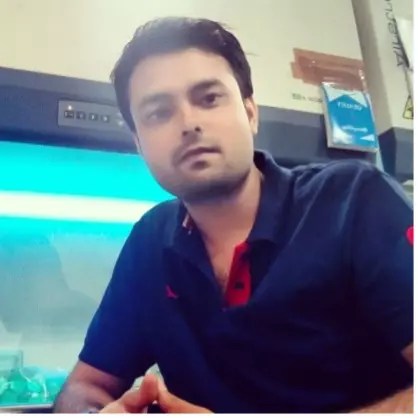Normal cells grow old and eventually die when they have reached their maximum lifespan. In these cells telomeres, the end of a chromosome, cannot be synthesized due to the suppression of the human telomerase reverse transcriptase (hTERT) enzyme, which results in telomeres shortening.
Although the link is still unclear, many studies demonstrated that the reactivation of hTERT results in telomere maintenance, which could lead to cancer. Meanwhile, it was shown that a couple of telomere-binding proteins interact with G-quadruplexes.
Since the hTERT promoter contains multiple G-quadruplex-forming sequences, in a recent study, scientists investigated whether telomere-repeat-binding-factor 2 (TRF2) associates with the promoter and whether this has an effect on hTERT regulation. Professor Shantanu Chowdhury, Shalu Sharma, Ananda Kishore Mukherjee, Shuvra Shekhar Roy, Sulochana Bagri, Dr. Meenakshi Verma, Antara Sengupta, Manish Kumar at the CSIR-Institute of Genomics and Integrative Biology in collaboration with Dr. Deo Prakash Pandey Silje Lier, and Gaute Nesse at the Oslo University Hospital discovered a telomeric factor-mediated mechanism of hTERT regulation, establishing molecular links between telomeres and telomerase that could be critical for neoplastic transformation, ageing, and regenerative therapy which was published in Cell Reports.

Scientists identified the TERT promoter sequence across vertebrates for G-quadruplex. They also performed a ChIP (chromatin immunoprecipitation) assay and analyzed it. In the meantime, since TRF2 is a genuine telomere-binding protein, telomere PCR was used as a positive control for TRF2 ChIP. Later they conduct serial experiments, including the immunoprecipitation of proteins, imaging with immunofluorescence microscopy to calculate TRF2 and hTERT signal intensity, immuno-flow cytometry, real-time PCR, blot analyses, ELISA, and a couple of other molecular assays.
Professor Chowdhury and colleagues demonstrated that TRF2 interacts directly with the hTERT promoter and controls hTERT expression and telomerase activity in cancer and normal cells. They also found that both MYB and the primary domains of TRF2 are required for hTERT transcriptional regulation; TRF2 regulates the epigenetic state of chromatin at the hTERT promoter; TRF2-induced recruitment of the polycomb repressor complex (PRC2) to the hTERT promoter.
The team found that TRF2 association with the hTERT promoter is not telomere-dependent but dependent on G-quadruplex. In addition, in cancers with hTERT promoter mutations, TRF2 occupancy is lost, and by stabilizing the G-quadruplex with ligands, TRF2 binding is restored, and activated telomerase is suppressed.
Their findings will help to understand more for ageing, cancer, cellular senescence, and DNA damage response processes related to the maintenance of telomeres and the regulation of telomerase. Lead author Professor Chowdhury said that: “The case of telomeres in cancer is particularly relevant. Although further work will be required to test this, based on our findings here, the establishment of telomere-telomerase crosstalk through TRF2 (telomeric along with non-telomeric binding at the hTERT promoter) may be key to how telomeres are managed in cancer cells.”
He also added: “Relatively enhanced levels of telomerase and long telomeres are crucial for maintenance/survival of pluripotent stem cells.” Therefore, TRF2-mediated hTERT regulation, linked to telomeres, could be significant in pluripotency.
This study showing for the first time that TRF2-induced re-suppression of hTERT in glioblastoma multiforme and other cancers using small molecule ligands offers a potential therapeutic opportunity. The small molecules were tailored to bind and stabilize G-quadruplexes. “These results present interesting opportunities for developing G-quadruplex-binding molecules for therapeutic intervention in glioblastoma multiforme – a devastating brain cancer” observed Prof. Chowdhury. In addition, the mechanisms that keep hTERT in a repressed state in normal cells and deregulation of which resulted in the reactivation of hTERT in cancer cells has been shown.
“Together, these results suggest molecular links between telomeres and telomerase that might be critical in advancing the understanding of cell-intrinsic functions, including neoplastic transformation, ageing, and pluripotency/differentiation,” said Professor Chowdhury.

Journal Reference:
Sharma S, Mukherjee AK, Roy SS, Bagri S, Lier S, Verma M, Sengupta A, Kumar M, Nesse G, Pandey DP, Chowdhury S. Human telomerase is directly regulated by non-telomeric TRF2-G-quadruplex interaction. Cell Rep. 2021 May 18;35(7):109154. DOI: 10.1016/j.celrep.2021.109154. PMID: 34010660.
About the Authors

Dr. Shalu Sharma, Ph.D.
After completing my Master’s in Microbiology, in 2014 Dr. Dr. Shalu Sharma joined Dr. Shantanu Chowdhury at CSIR-IGIB for PhD. SC lab studies cancer with focus on telomere biology. She began by exploring the regulatory effects of telomeres on cellular ageing and genome-wide transcriptomics. Gradually, she gained interest in understanding regulation of human telomerase, hyper-activated in >90% cancers. The research team’s recent findings reveal how telomeres might signal telomerase regulation. How clinical mutations on telomerase promoter cause telomerase hyper-activation. Based on this, the team found the potential of DNA-binding small molecules for therapeutic interventions.

Dr. Ananda K Mukherjee, Ph.D
Dr. Ananda K Mukherjee joined as a graduate student in Dr. Shantanu Chowdhury’s laboratory at IGIB in 2014 where he was introduced to telomere biology and the telomere binding protein-TRF2. The team made an interesting observation that the non-canonical transcriptional effects of TRF2 was telomere length dependent. Subsequently, they noted that TRF2 directly represses telomerase by maintaining suppressive histones using G-quadruplexes on the gene promoter. They further found that specific G-quadruplex disrupting glioblastoma mutations led to loss of this regulation. He is presently trying to understand how telomere length heterogeneity of tumor cells could influence the immune response to cancer.

Professor Shantanu Chowdhury, Ph.D.
Shantanu Chowdhury is currently a professor at the CSIR-Institute of Genomics and Integrative Biology in Delhi. His research interests include understanding the function of non-duplex DNA structures called G-quadruplexes. Particularly, in telomerase control and telomere function in cancer. In 2002 he moved to his current position where he started his own laboratory. In 2012, Shantanu received the Shanti Swarup Bhatnagar Award in Biological Sciences (most prestigious Science Prize in India). He is a Senior Fellow of the DBT / Wellcome Trust India Alliance and is a member of the editorial board of the Journal of Biological Chemistry.
Main Image Credit: Chowdhury et al https://doi.org/10.1016/j.celrep.2021.109154















































